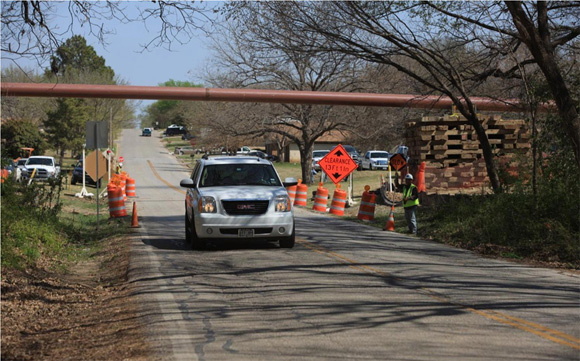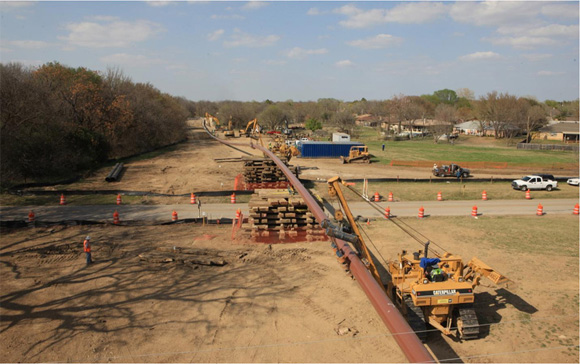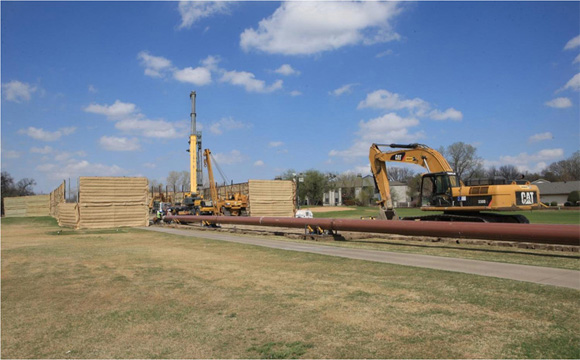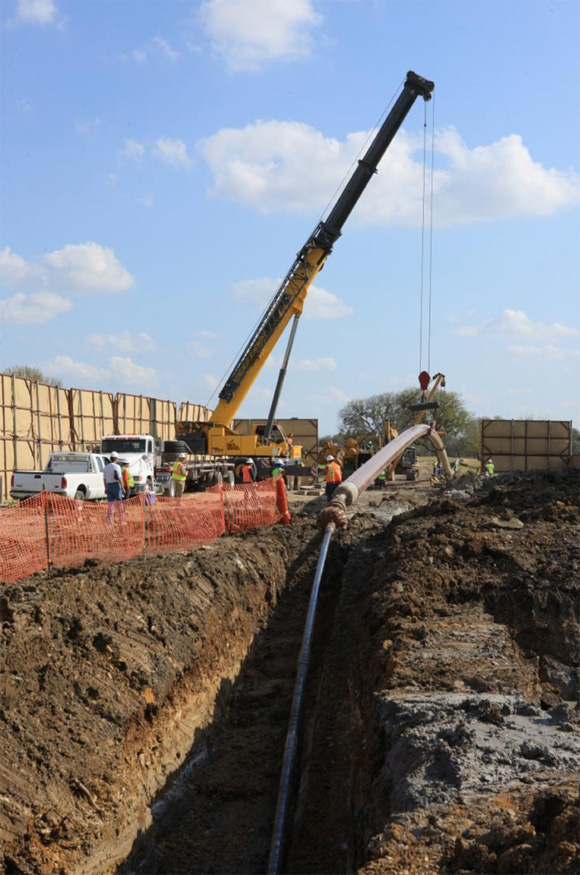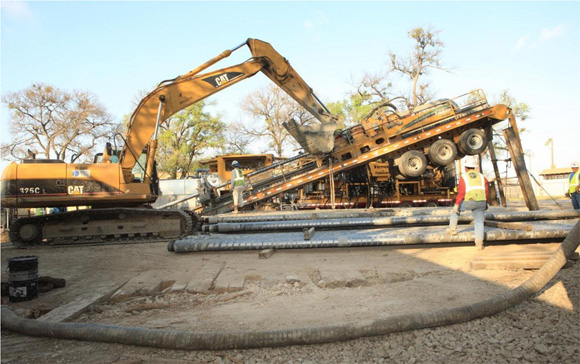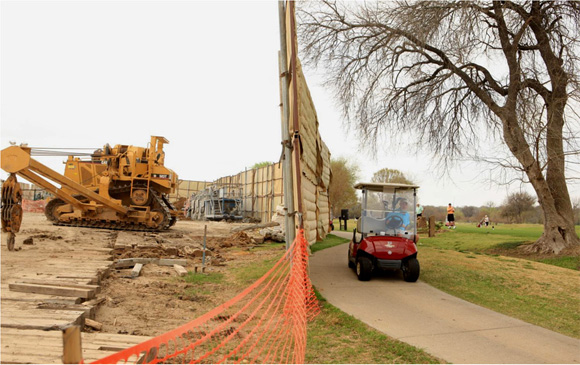by
Melrose Resources , Inc. | Sep 19, 2011
Melrose Resources flirts with HDD record; completes a 1.13-mile (1.8 km) bore — through rock — in one straight shot
| Written by: | Randy Happel, Features Writer
Two Rivers Marketing |
| On Behalf of: | Vermeer Corporation
Pella, Iowa |
The project traversed two affluent Fort Worth, Texas, suburbs, beneath the immaculate fairways and sculptured greens of two golf courses, tree-lined streets and posh neighborhoods … and ranks among the longest continuous bores in trenchless pipeline history. Affectionately known by officials with project owner Chesapeake Midstream Partners as FRAP (Fossil Ridge to Arc Park), the 5967-foot (1818.7 m) section of underground pipeline has the distinction of being the longest horizontal directional drilling (HDD) bore attempted in Chesapeake Energy Corporation’s history related to the massive natural gas deposits of Barnett Shale.
Completed by Melrose Resources , headquartered in Irving, Texas, the bore was the second of a three-phase, 29,952-foot (9129.4 m), 6.25-mile (10.1 km) installation of a 24-inch (61 cm) pipeline to connect a main compressor station (in the suburb of Arc Park) with well pads northeast of downtown Fort Worth. The FRAP pipeline serves as a gathering and transportation route for the immense deposits of natural gas contained within the Barnett Shale, connecting 12 different natural gas sites containing more than 55 wells in Fort Worth, North Richland Hills, Haltom City and Hurst, Texas. All future sites proposed in the north Loop 820 area will also utilize FRAP.
A path less traveled
After months of planning and preparation, more than a dozen of the best site managers, engineers and safety experts in the trenchless business were on site as the project kicked off at North Park in Haltom City, Texas. Prior to beginning the actual installation of Phase 2, however, a supporting cast composed of countless Melrose Resources and Chesapeake Midstream staff worked in concert to stage the above-ground production, a difficult task considering the length of the pipeline, sensitivity to maintaining the integrity of the opulent surroundings and the many restrictions imposed by different municipalities and private and commercial interests.
After months of preparation, Chesapeake identified a path that routed the pipeline through urban surroundings to its intended destination. Although FRAP was pulled across and under high-volume roads, as well as beneath public areas such as parks and golf courses, there was minimal interruption or inconvenience as most residents and businesses along the mile-plus route had no idea what was taking place some 135 feet (41.2 m) below — a depth equivalent to that of an inverted nine-story building — beneath the surface.
“Location, location, location,” says Melrose Resources HDD Superintendent Harold Kay when commenting specifically about project challenges. “Most would assume the length of the bore and the rock would be primary concerns, but we were confident in the capabilities of the equipment. On this job, it was a combination of other factors, especially restricted access. The drill plan crossed under two golf courses, wetlands, along with deep creek beds with a lot of brush and trees. Restricted access to the middle of the bore route was an initial challenge.”
Rock around the clock
From the staging area that had been established in a city park, surrounded by a Frisbee course and ball fields, encompassed and camouflaged by a massive 16-foot (4.9 m) tall wall barrier to minimize sound disruption for nearby residents, the Melrose Resources crew secured their Vermeer D1000x900 Navigator® horizontal directional drill, and began the 3-month, 24/7 drilling project. They selected an 8-3/4-inch (22.2 cm) rotor cone bit with mud motor, and 30-foot (9.1 m) sections of 5-inch (12.7 cm) diameter drill pipe, for the pilot bore.
With such tight tolerances (18 inches [45.7 cm] left to right) specified in the bore plan, there was little room for error. While the entry angle of 15 degrees, en route to an average drilling depth of 120 feet (36.6 m), might be considered somewhat steep, Kay explains the rationale; reasoning known only by those familiar with the topography and previous knowledge of the area.
“Having extensive experience in and around the Fort Worth area, we were already aware of a rock ledge that exists at about 32 to 34 feet (9.7 to 10.4 m) below the surface,” Kay says. “If first contact with that ledge is made at less of an angle, say six to seven degrees, the drill bit is likely to deflect and skip off the top. When this happens, the radius is too small for accommodating the large-inch diameter pipe. At the 15-degree entry angle, we felt confident that when we reached the rock, the angle was sufficient for the bit to grab and hold on the first try. It worked like a champ.”
The Melrose Resources crew worked around the clock, safely navigating and boring — unseen, for the most part — beneath bustling roadways, quiet cul-de-sacs and tranquil fairways. Kay, along with John Langford, general superintendent in charge of directional drilling and surveying at Melrose Resources , and Richard Norton, senior superintendent, had complete confidence in the crew and capabilities of the equipment.
“We were confident going into the job because of the experience we have with other trenchless installations in the area,” Langford says. “But we also had a great deal of confidence in the capabilities of the Vermeer drill, having used their equipment for several years now. The rock and shale of the Barnett formation have been conquered time and time again using this equipment. The greater challenge facing us here was logistics.”
Set design
Space restrictions and limited accessibility dictated that the initial staging area begin small with all the spoil being removed from the bore path and hauled away via vacuum trucks. Spoil not removed by vacuum, i.e., larger solids, were hauled off site daily by dump trucks. A driveway leading into an apartment complex was established as the site for the exit pit, with 24-hour guards posted to control traffic flow, restrict public access and assist residents in navigating around equipment barriers. From there, a winding rock road was constructed through a heavily wooded area to a phasing area that had been established near the golf course.
After 15 days of near-continuous drilling, the pilot bore was completed successfully with what Kay refers to as “only minor glitches,” and the Driver team of trenchless experts was eager to get underway with backreaming and pullback. This required three additional bores of 18, 26 and finally, 36 inches (45.7, 66 and 91.4 cm), to achieve the circumference required to accommodate the 24-inch (61 m) X65 FBE coated steel pipe during pullback. As Kay explains, although X65 FBE steel with .375 or .500 wall pipe is typically specified by Chesapeake for HDD-installed bore sections. Based on the maximum operating pressures of the pipeline it is also required in Class IV locations, i.e., areas in proximity to homes and businesses, as opposed to more rural, open-space areas.
“Since we were cutting mostly through rock and shale, we felt it best to retool the reamer for the 18- and 36-inch (45.7 and 91 cm) bores,” Kay explained. “We cut just over 3000 feet (914.4 m) and then pushed the reamer back out and installed new cones and cutters. Our rotary torque was very low, a big advantage with using the Vermeer drill, and the rate of penetration stayed about the same from start to finish. The 26-inch (66 cm) ream, being the in-between shot, we were able to make in one solid cut without pushing out. It had been a long time since we made a crossing of that distance and we didn’t want to get 4000 feet (1219.2 m) into it and have reamer problems. We knew the drill could handle it, there was just no reason to push the reamer.”
Staging pullback
After completing the pilot bore in 15 days, the Melrose Resources crew was able to facilitate completion of the three reaming bores in 28 days, averaging approximately 360 feet (109.7 m) every 12 hours, all while preparing the pipe for its final journey — and permanent home — situated some 120 feet (36.6 m) securely underground. Pullback of more than a mile (1.6 k m) of steel pipe was all that remained to secure another successful installation for the cast and crew of Melrose Resources . True to form, this last and greatest logistical challenge was staged with meticulous care and ultimate precision.
“We assembled the pipeline in five separate sections,” Norton explains. “We had a laydown area at the edge of the drill that went across the golf course, onto a small city park, then continuing Onyx Street to Broadway. We built an 1800-foot (548.6 m) timber matted path on the golf course and set our rollers to assist in the pullback, one section at a time. We were granted a 14-foot (4.3 m) clearance from the surface of Onyx Street to where the pipe was suspended above to allow for traffic to pass underneath. Once we got to a section or got another section ready to weld, we’d stop, make that weld, do the x-ray, apply the coating and move on to the next. When the first four sections had been welded and staged, we began pulling back through until we got in about 200 feet (60.1 m), made the last weld, and pulled the pipeline back through.”
The Melrose Resources crew used a bentonite mud and soap mixture to lessen resistance and facilitate the pullback of the 377.8 tons (342.8 tonnes) of material, along with 152,159 pounds (69,018.2 kg) of 6-5/8-inch (16.8 cm) drill stem, totaling over 450 tons (408.2 tonnes). The final pullback performance took 15 hours, followed by another 15-1/2 hours of pulling up mats.
With the pipeline now firmly situated in its permanent underground home and the staging mats removed from the three holes along Diamond Oaks Country Club, Kay gave the “all clear” signal to the clubhouse and play on the three affected golf holes resumed — after only a one-day delay — as the Melrose Resources crew started packing up.
Rave reviews
Aside from a few minor procedural glitches, Mike Tucker, FRAP’s project manager for Chesapeake Midstream Partners, struggled to identify something about the project that didn’t go according to plan.
“In the 30-plus years I’ve been in the business, this is one of the most unique jobs I’ve ever been involved with,” Tucker said. “I’ve had projects where we drilled pipelines in the 4000- to 5000-foot (1219.2 to 1524 m) range, but we weren’t in residential areas with apartments and golf courses like this. You go back 10 years and this length might have been a world record, especially when you consider the entire length was in solid rock. But technology and equipment has advanced so far in the last several years that we’re able to do this with greater confidence.”
Gregg Wideman, general manager of Diamond Oaks was pleased as well, not only for the minimal disruption imposed on club members, but with the immaculate condition of the course upon completion and the courtesy extended to him and fellow golfers. He said that even though three holes were taken out of play for a day to give workers space to operate, most club members appreciated why Driver and Chesapeake were there, and aware that the interruption would be temporary.
After construction had been completed, Melrose Resources ’s Dale Baughman reiterated the satisfaction and gratification expressed by the hundreds of affected residents, businesses and golfing enthusiasts.
“We’re here today, gone tomorrow,” Baughman says. “A little bit of inconvenience means a lifetime of good that’s going to come out of this. Being able to get this gas out, use it, get it to market, I think it’s all absolutely a good thing.”
Photos
